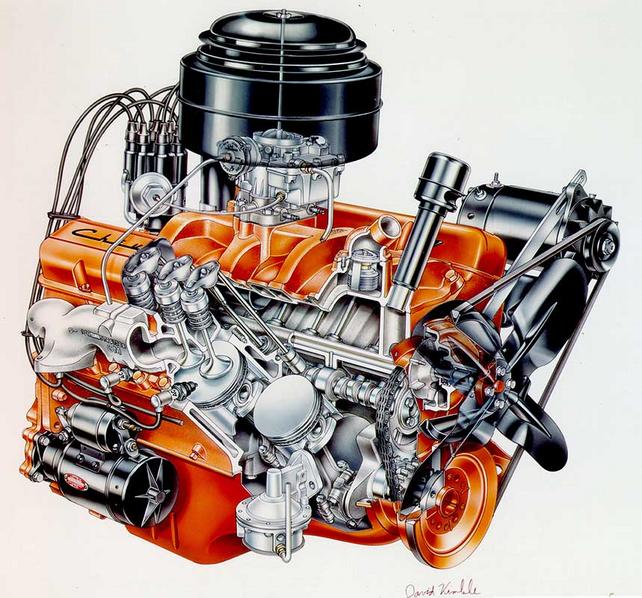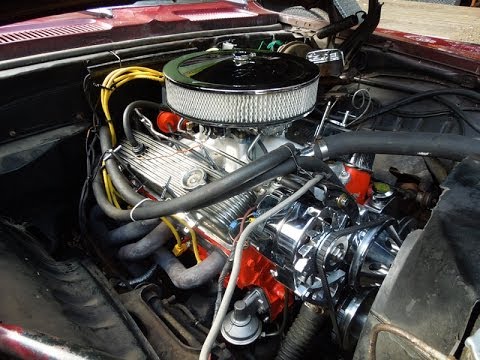The Chevy 350-cubic-inch engine was the most popular engine by General Motors and while it is no longer produced for new GM cars and trucks, it can be purchased as a replacement engine. With this Chevy 305 Engine Diagram and troubleshooting guide, you should be able to install and fix any issues you will ever have with this engine.
Chevy 350 Engine Diagram


About the Chevy 350 Engine
The Chevy 350 is considered one of the best engines of the 20th century due to its durability, quiet operation, and performance which has earned it a reputation for usability in many applications including boats.
The engine first started out as a 256 cubic inch (4.3-liter) engine in 1955. By 1967, it had grown into the 350 cubic inch engine. The small-block V8 engine featured a 4.00 and 3.48-inch bore and stroke. The horsepower ranges from 145 to 370 hp. The engine delivers 380 pound-feet of torque which makes it great for towing though it is not as great when it comes to fuel economy.
Troubleshooting a Chevy 350 Engine
If your Chevy 350 engine is not starting, you might be dealing with a spark plug problem or low on fuel. If the problem is not with the ignition or fuel, you could go on to check for electrical and/or mechanical problems
Check Fuel
You can check for a fuel problem by spraying carburetor cleaner into the carburetor. When done, start the vehicle. If it starts, then you have confirmed that there is no fuel problem, you can go ahead with other checks.
If you have a mechanical fuel pump and the lines are not clogged, you should replace the mechanical pump. If you have an electric fuel pump, inspect the relay to see if is bad and replace it if so. However, if the relay is good, then check for power at the electrical fuel pump.
Check Ignition
Check the ignition by checking the spark plug. Pull the spark plug wire off the spark plug and stick an extra spark plug into the end of the wire. Lay it on the intake manifold or valve wire. Let a helper turn the engine over and you watch for spark at the spark plug.
If you see a spark, then the ignition is working fine. If not, go ahead to remove the distributor cap to check if the rotor is worn. Using a feeler gauge, make sure that the points are properly adjusted. You can use a matchbook cover to check points for the engine.
To check the coil for voltage going into the coil, place the positive lead of the voltmeter on the B+ terminal on the coil and the negative lead to a good ground. Turn the key on. You should read 12 volts. If there is no voltage going into the coil, check the ignition switch and then check the wiring between the ignition switch and the coil.
Check Battery and Alternator
Using a voltmeter, you can check if the battery has voltage. Touch the positive terminal of the battery with the positive lead of the voltmeter and the negative terminal with the negative lead of the voltage meter. If the volts read below 12.00 then the battery should be charged before further testing.
When the battery is charged, start the vehicle and touch the battery terminals with the respective voltmeter leads as you did in the previous testing. If the voltmeter reads higher than 12 (show 13.50 to 14.75 volts), the alternator is charged properly. Turn the vehicle off and watch the voltmeter while a helper starts the vehicle. If the voltmeter drops below 10.75 while the vehicle is being started, it shows that the battery will not hold a charge and should be replaced.
Check Starter
With the ignition key on, check for power at the starter’s B+ terminal if the alternator and battery are good. If there is no power at the terminal, then check the starter relay. If the starter relay is in good working condition, then the starter is bad and should be replaced.
Chevy 350 Engine Problems
Hard Starting
The Chevy 350 usually has a problem starting in cold weather, especially with temperatures near freezing. If the 350 engine fails to start, the problem could be due to the automatic choke being in the closed position. The closed choke can be determined through the smell of gasoline from the engine compartment. The air cleaner must be removed and the choke plate inspected to ensure that it is swiveling to open and close.
Tapping/Clicking Valves
Chevy 350s that have been sitting for a long period could develop a tapping or clicking sound once the engine is running. The reason for this could be due to the oil galleys being blocked or restricted. It could also be due to low oil pressure. The galleys should be cleared and the oil pump should be replaced. Aftermarket oil pumps are quite better than the standard older versions and generate about 60 to 80 psi when in use.